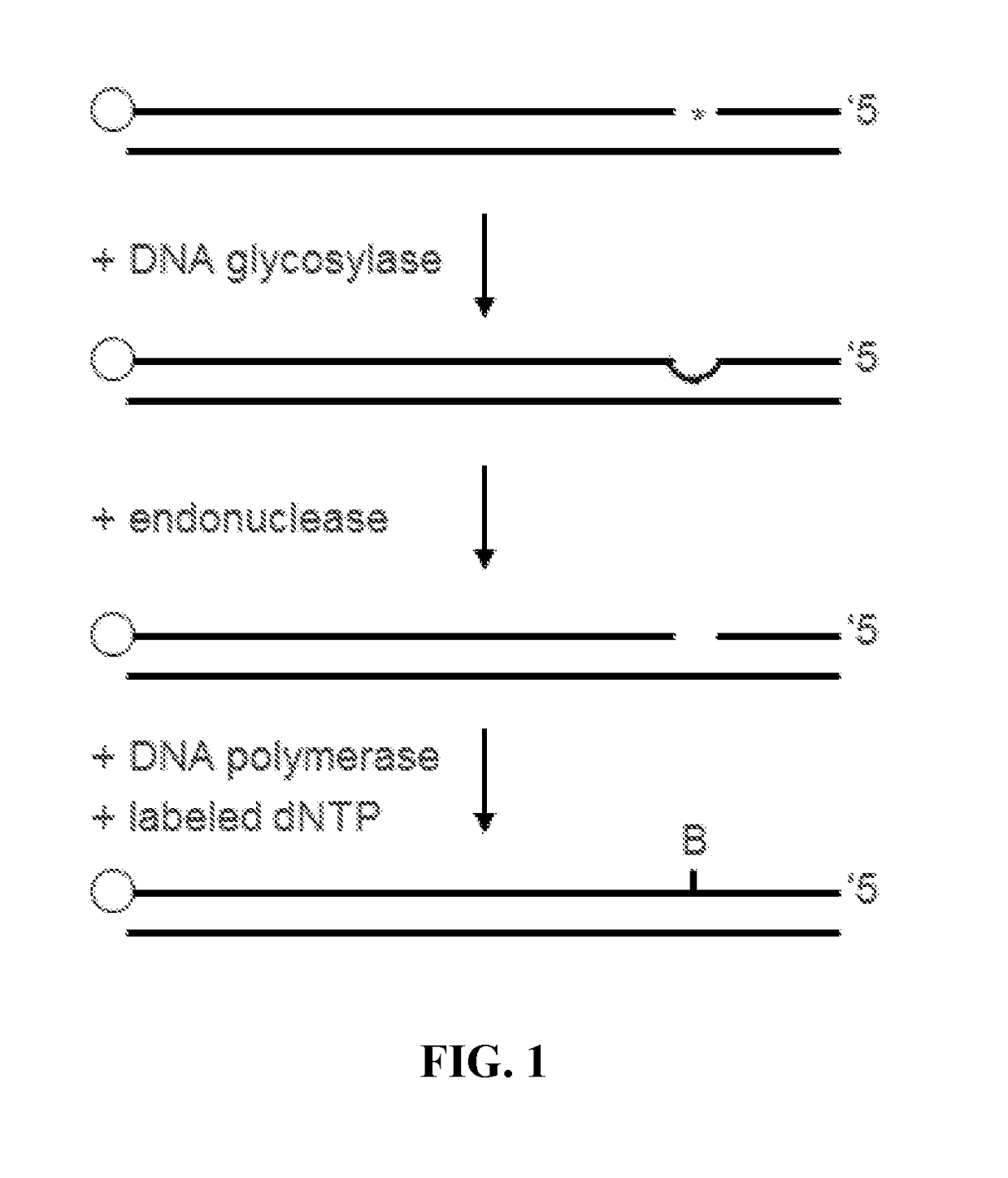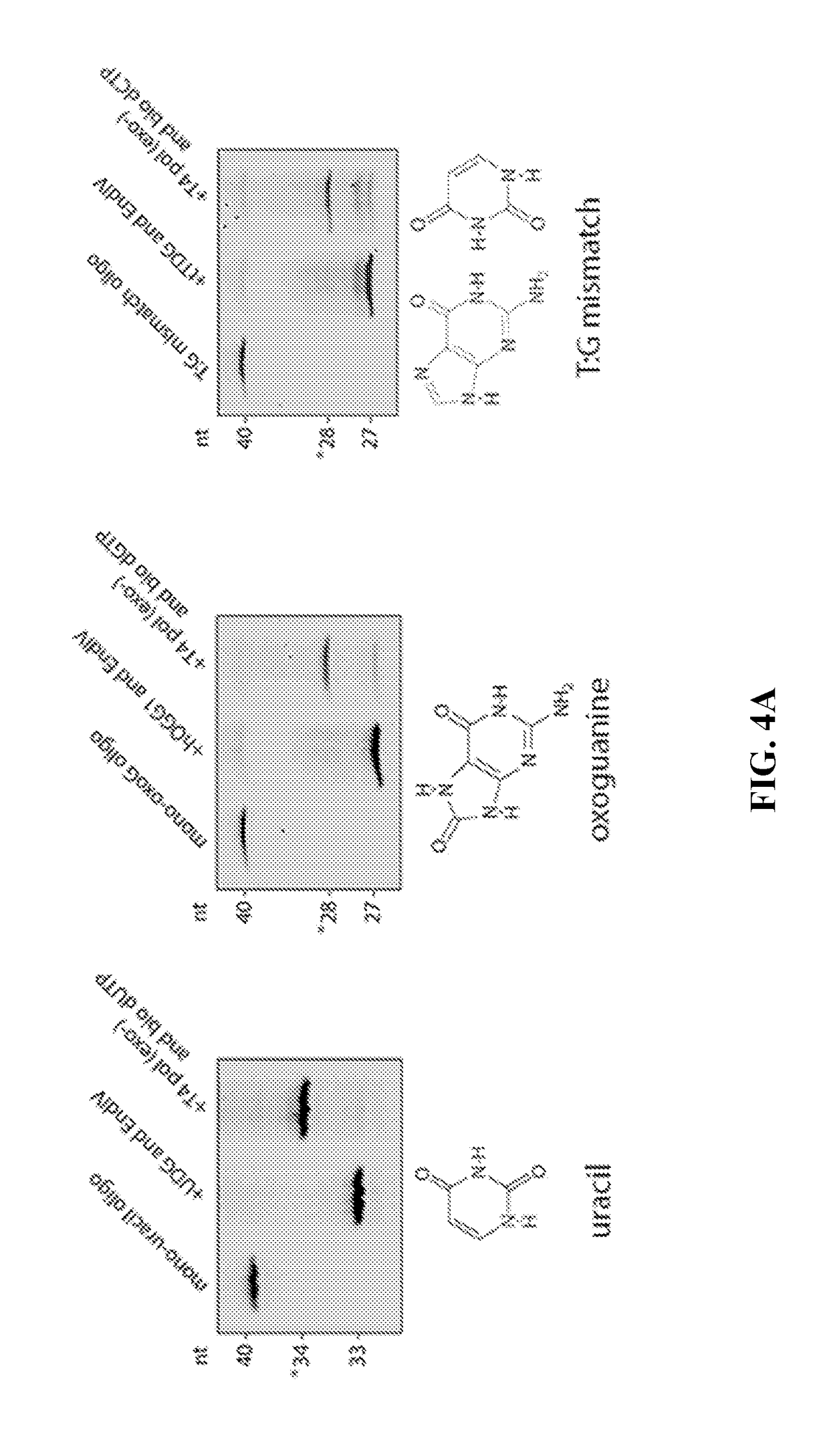Identification of genetic modifications
a technology of genetic modification and identification, applied in the direction of enzymology, drug composition, transferases, etc., can solve the problems of limited chemical stability of bases, affecting their base-pairing properties, and mitochondrial dna also experiencing significant oxidative damage, so as to reduce side effects
- Summary
- Abstract
- Description
- Claims
- Application Information
AI Technical Summary
Benefits of technology
Problems solved by technology
Method used
Image
Examples
example 1
[0225]A study was performed to identify DNA polymerase properties useful for labeling methylated or damaged nucleotide bases in genetic sequences. Of specific interest was whether the labeling reaction could be improved by using a DNA polymerase that lacked 3′→5′ proofreading exonuclease activity. It was hypothesized that 3′→5′ exonuclease activity could result in excision of incorporated labeled bases, which would reduce the efficiency of the labeling reaction. Such exonuclease activity could also result in excision of additional nucleoside bases in the 5′ direction from the excised base. Because the polymerase is supplied with only one (biotin-conjugated) nucleoside, this is most likely to cause the polymerase to either (i) pause permanently at a base 5′ from the target, resulting in no label incorporation, or (ii) incorporate a labeled nucleoside at a site 5′ from the targeted modified base, leaving a gap and misidentifying the position of the modified base. As such, using a DNA ...
example 2
[0234]A study was performed to identify DNA polymerase concentrations useful for labeling methylated or damaged nucleotide bases in genetic sequences. Of specific interest was whether the labeling reaction could be improved by limiting the availability of DNA polymerase. This is because excess polymerase concentration can have spurious effects, including elevated error rates (misincorporation), untemplated incorporation, and interference that can lower activity, while too limited availability can result in low yield (that is a lot of unlabeled DNA). To test this hypothesis, a titration experiment assessing various DNA polymerase concentrations was performed.
[0235]The same DNA construct as described in Example 1 was used for this study. Excision of the uracil base was also performed as described in Example 1 on a total of about 50 μg of DNA construct. The resulting material was purified using a commercial kit (Qiagen), suspended in 10 mM Tris-HCl, pH 8.5 and divided into 13 aliquots ...
example 3
[0239]Using the conditions worked out in Examples 1 and 2, the detection method of the disclosure was used to specifically excise and label uracil, oxoguanine, and T:G mismatches. Three DNA constructs were prepared, each construct containing a single uracil, oxoguanine, or T:G mismatch. FIG. 4A shows the migration patterns of each DNA construct (left lane of each gel). The glycosylase and endonuclease pairings were: (1) uracil: UDG and Endo VI; (2) oxoguanine: hOOG1 and Endo IV; and (3) T:G mismatch: TDG and Endo IV. All samples were first treated with glycosylase and endonuclease and then purified by column filtration prior to the polymerase step. The TDG reaction product is treated with proteinase K following TDG incubation and purified by column filtration prior to subsequent endonuclease and polymerase steps, requiring an additional purification step relative to UDG and hOGG1. Co-incubation of the DNA constructs with the respective glycosylase / endonuclease pairing resulted in cl...
PUM
| Property | Measurement | Unit |
|---|---|---|
| Time | aaaaa | aaaaa |
| Length | aaaaa | aaaaa |
| Displacement | aaaaa | aaaaa |
Abstract
Description
Claims
Application Information
 Login to View More
Login to View More - R&D
- Intellectual Property
- Life Sciences
- Materials
- Tech Scout
- Unparalleled Data Quality
- Higher Quality Content
- 60% Fewer Hallucinations
Browse by: Latest US Patents, China's latest patents, Technical Efficacy Thesaurus, Application Domain, Technology Topic, Popular Technical Reports.
© 2025 PatSnap. All rights reserved.Legal|Privacy policy|Modern Slavery Act Transparency Statement|Sitemap|About US| Contact US: help@patsnap.com



